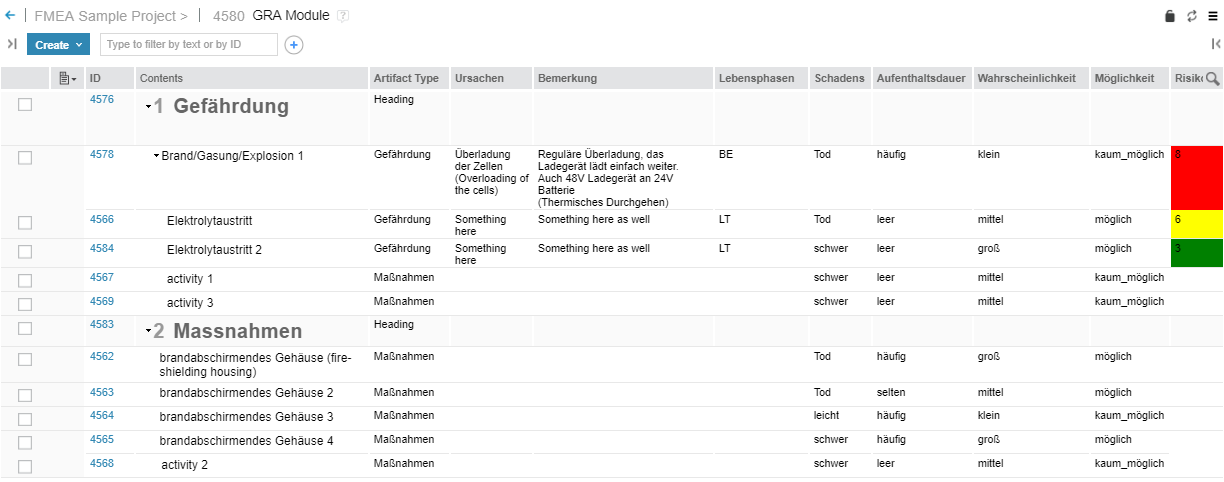FAILURE MODE AND EFFECTS ANALYSIS (FMEA)

Overview

What is FMEA?
Failure Mode and Effects Analysis (FMEA) is a structured approach to discovering potential failures that may exist within the design of a product or process.
Failures are errors or defects, and can be potential or actual. Failure modes are the ways a product or process fails. (You can also say it defines what happened that caused it to go wrong and especially how it went wrong.)
Failure effects are the ways these failures can lead to waste, defects, or harmful outcomes. These consequences could include user injury, machine or process malfunction, or poor product quality. The system failure could also affect other systems directly related to it. Effects analysis studies how failures impact different system components.
FMEA is a procedure used to pinpoint where certain systems or machinery might fail. That way, your team can set up a plan to proactively fix those systems. By reviewing as many components and subsystems as possible, you can identify the system’s potential failure modes and their root causes.


It also documents actions and knowledge about risks and helps with continuous improvement.
We can understand Failure modes as modes and ways, in which something might fail. Failures can be actual and potential and we define them as errors and defects.
Effects Analysis helps us study the consequences of those failures.

When to use FMEA?
- Design or redesign of product or service
- New ways of applying existing product or service
- Throughout the life of the product or service
- Analyzing failures of an existing product or service
- Improving existing product or service
- Developing control plans for processes
Why do I need FMEA?
A successful FMEA activity helps identify potential failure modes based on experience with similar products and processes—or based on common physics of failure logic. It is widely used in development and manufacturing industries in various phases of the product life cycle. Effects analysis refers to studying the consequences of those failures on different system levels.


Types of FMEA analyses
A few different types of FMEA analyses exist, such as:
- Functional
- Design
- Process
Sometimes FMEA is extended to FMECA (failure mode, effects, and criticality analysis) to indicate that criticality analysis is performed too.

The steps of FMEA
Planning and Preparation is the first step of the FMEA process. It helps teams be more efficient throughout the process and achieve set goals by defining project plans and details.
Softacus FMEA Tools for IBM Jazz
IBM software provides Failure Mode and Effects Analysis (FMEA) feature set. This enables the product development team to identify, define, and control the mitigation of risks, while ensuring traceability between requirements, failure modes, and test cases. IBM provides out of the box FMEA extension for IBM Jazz Platform which is installed in /RM component. Extension enables users to:
- Choose attributes like probability, severity, impact
- Automated or manual calculation of risk priority number (RPN)
- Linking of FMEA artifacts to affected requirements and to mitigation requirements
- Out of the box Gap Analysis
- With help of Softacus FMEA extension we are also able to:
- Compare RPN before and after mitigation
- Color-code RPN based on the value
- Adjust the FMEA calculation to any of your needs
- Provide it for free to our IBM Jazz customers
With help of Softacus FMEA extension we are also able to:
- Compare RPN before and after mitigation
- Color-code RPN based on the value
- Adjust the FMEA calculation to any of your needs
- Provide it for free to our IBM Jazz customers
IBM software provides Failure Mode and Effects Analysis (FMEA) feature set. This enables the product development team to identify, define, and control the mitigation of risks, while ensuring traceability between requirements, failure modes, and test cases. IBM provides out of the box FMEA extension for IBM Jazz Platform which is installed in /RM component. Extension enables users to:
- Choose attributes like probability, severity, impact
- Automated or manual calculation of risk priority number (RPN)
- Linking of FMEA artifacts to affected requirements and to mitigation requirements
- Out of the box Gap Analysis
- With help of Softacus FMEA extension we are also able to:
- Compare RPN before and after mitigation
- Color-code RPN based on the value
- Adjust the FMEA calculation to any of your needs
- Provide it for free to our IBM Jazz customers
With help of Softacus FMEA extension we are also able to:
- Compare RPN before and after mitigation
- Color-code RPN based on the value
- Adjust the FMEA calculation to any of your needs
- Provide it for free to our IBM Jazz customers
Capturing Failure Mode and Effects Analysis
FMEA Script and Template for Rail Industry
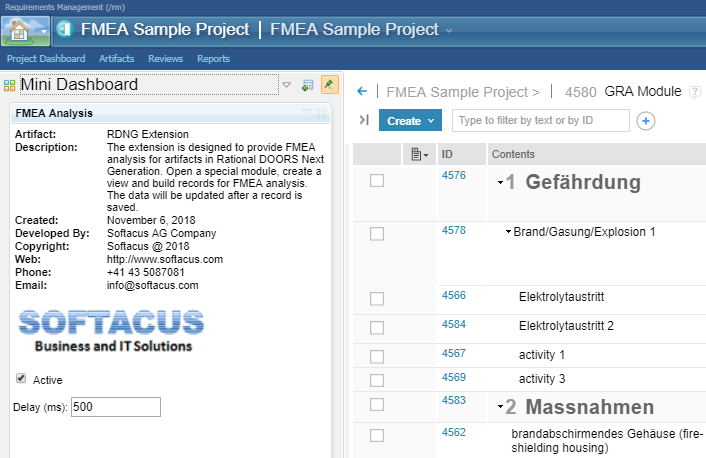
User interface
- DOORS Next Generation application, which is delivered in Jazz CLM tools by IBM, supports extending its base features by specially developed programming units conformed to OpenSocial specification. FMEA extension developed by Softacus AG can give you important capabilities if you work with Failure mode and effects analysis (FMEA). A successful FMEA activity helps identify potential failure modes based on experience with similar products and processes.
Explanation and features
The main features of the FMEA extension are:
- Calculating Risikozahl Type based on such input data as the extent of damage, length of stay in the danger zone, probability of occurrence, and the possibility of avoiding the danger.
- Supported work in modules
- Painting colors based on calculated values in accordance with the next scale:
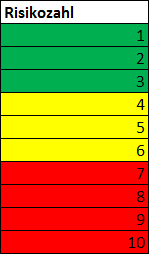

Explanation and features
The main features of the FMEA extension are:
- Calculating Risikozahl Type based on such input data as the extent of damage, length of stay in the danger zone, probability of occurrence, and the possibility of avoiding the danger.
- Supported work in modules
- Painting colors based on calculated values in accordance with the next scale:
Known Problems:
- If an artifact in DNG Module is selected the color will now be showing. The reason for that is that IBM implemented rosa color for highlighted requirements. As soon as you deselect the requirement desired color appears. Reload will also make the color appear. The gadget must be open at least once after the user started his Web browser's session.
Limitations:
- Works in Module
- The cells are colored after 0.5 seconds delay due to technical reasons of Jazz. The color will not appear if your jazz is slow. We can fix it by increasing 0.5 seconds to 5 seconds.
Pricing
-
This add-on is free of charge for customers who purchased the IBM Jazz solution via Softacus.
Please contact us if you need a different arrangement.
FMEA Extension
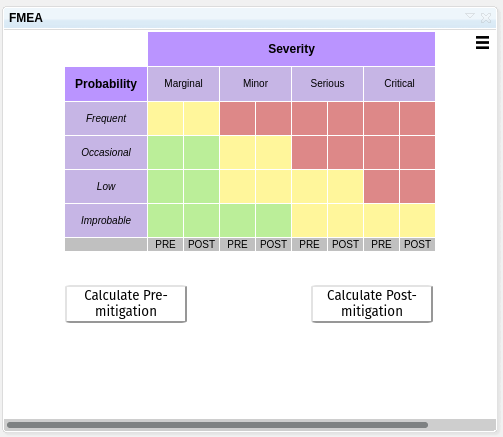
Explanation and features
- Widget calculates Risk Acceptance attribute based on Probability and Severity
- Widget calculates the Risk Acceptance for "Pre-mitigation" attributes as well as "Post-mitigation" attributes
- Upon selection, widget shows in table what is the probability and severity of current artifact and what Risk Acceptance Value is there
- User has ability to Calculate Risk Assesment for either selected artifacts, selected view or whole module
- If there are any miscalculations between attributes, widget displays a message
- If there is no calculated value or the value is incorrectly calculated (edited by user or by import) the widget will display a message
How to use this extension
- Open Module in Doors NG Component If the user wants, he can select some artifacts or select a view Upon clicking the button, the desired scope is updated based on each artifact's attributes There is also just a use case, where you want to check only one artifact, which is triggered upon selecting one After selecting one artifact, the desired information is displayed in the widget
FMEA Extension
- This extension allows users to calculate Risk Acceptance based on specified attributes as in the table.
- Upon selecting an artifact, the widget shows the current artifact Risk Acceptance and its other Risk attributes in the table.
Restrictions
- The script cannot be executed outside of the module
FMEA Validation Extension
Explanation and features
- Widget calculates Risk Class and Risk Priority attribute based on Risk Likelihood, Severity of Impact and Probability of Detection
- Upon selection, widget shows in the table what is the probability and severity of current artifact and what Risk Acceptance Value is there
- User can Calculate Risk Assessment for either selected artifacts, selected view, or whole module
- If there are any miscalculations between attributes, the widget displays a message
- If there is no calculated value or the value is incorrectly calculated (edited by the user or by import) the widget will display a message
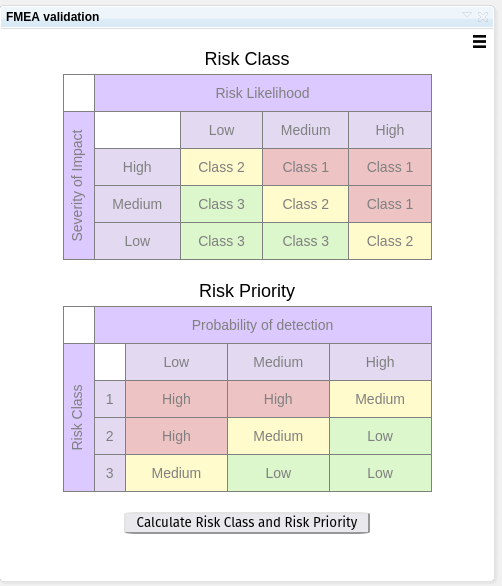
How to use this extension
- Open Module in Doors NG Component If user wants, he can select some artifacts or select a view Upon clicking the button, the desired scope is updated based on each artifact's attributes There is also just usecase, where you want to check only one artifact, which is triggered upon selecting one After selecting one artifact, the desired information is displayed in the widget
FMEA Extension
- This extension allows users to calculate Risk Class and Risk Priority based on specified attributes as in the table.
- Upon selecting an artifact, the widget shows the current artifact Risk Class and Risk Priority and its other Risk attributes in the table.
Restrictions
- The script cannot be executed outside of the module
FMEA for your Business
Do you have any questions about our products? Do you need custom FMEA for your business? Let us know.

